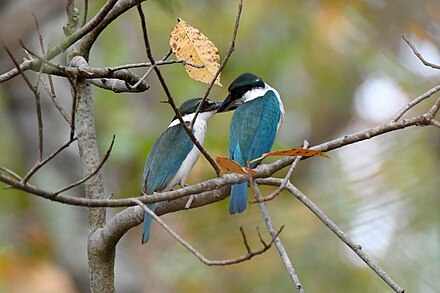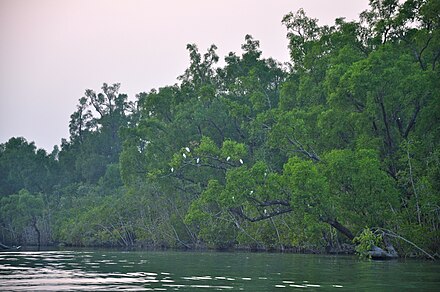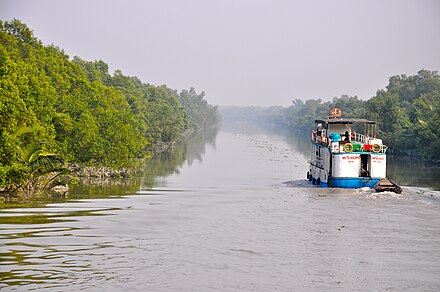Sundarbans (Bangladesh) - part of the Sundarbans in Bangladesh
The Sundarbans are a huge mangrove forest in Khulna Division of Bangladesh, on the coast of the Ganges Delta by the Bay of Bengal. It is part of a UNESCO World Heritage Site and famous as a sanctuary of the Bengal tiger.
This article covers three wildlife sanctuaries in Khulna Division, including Sundarbans South Wildlife Sanctuary, Sundarbans East Wildlife Sanctuary and Sundarbans West Wildlife Sanctuary. The part in India is covered in Sundarbans (West Bengal).
Understand
The Sundarbans are the largest littoral mangrove belt in the world, stretching 80 km (50 mi) into the Bangladeshi and Indian hinterland from the coast. The Sundarbans has been declared a UNESCO World Heritage Site. The forests aren't just mangrove swamps though, they include some of the last remaining stands of the mighty jungles which once covered the Gangetic plain. The Sundarbans cover an area of 10,500 km<sup>2</sup>, of which about one-third is covered in water or marsh areas. Since 1966 the Sundarbans have been a wildlife sanctuary, and it is estimated that there are now 400 Royal Bengal tigers and about 30,000 spotted deer in the area.
Flora and fauna
The chief predators are the Bengal tiger, clouded leopard, saltwater crocodile, black panther and fishing cat. The Sundarbans is home to many different species of birds, mammals, insects, reptiles and fishes. Over 120 species of fish and over 260 species of birds have been recorded in the Sundarbans. The Gangetic River Dolphin (Platanista gangeticus) is common in the rivers. No less than 50 species of reptiles and eight species of amphibians are known to occur. The Sundarbans now support the only population of the Estuarine, or Salt-Water Crocodile (Crocodylus parasus) in Bangladesh, and that population is estimated at less than two hundred individuals.
The park is also home to sea gypsy fishing families who catch fish using trained otters.
Climate
- October to February — winter, cool and temperate
- March to May — summer, hot and humid
- June to September — the monsoon season, wet and windy
Get in
Safaris are available from Dhaka and Khulna. These trips range from being overnight to a week and are probably the best way to experience the Sundarbans. Some of the agencies offering package tours:
- Arranger Tours and Travels, 6 Farazi Para Main Road, Khulna, Tel: +88041723031, +8801817-403070, (dead link: January 2023)
- Ever Green Tours, Tel: +8801711-942555, +8801911-080077
- Pugmark Tours and Travels, KDA Building, Shibbarirmore, Khulna, Tel: +8801715-167740, +8801919-298001, As of December 2018, the price for 3-4 day trip is around Tk 15-20000.
Organizing your own trip from Munsiganj-Satkhira, Mongla or Khulna is possible (and cheaper, if you're a shrewd negotiator), but questionably worth the hassle. You need a permit from the Divisional Forest Office in Khulna. With permit in hand, it's possible to hire a boat from Mongla or Dhangmari to get you to Hiron Point. From Hiron Point you will have to hire a guide to take you into the park.
Day trips from Mongla are not very interesting, and probably better avoided. After negotiating the price of a boat down to something only slightly less ridiculous you'll most likely be taken to Karamjal Wildlife Center, where there are some tame deer to feed and some monkeys, crocs and snakes in cages. But surely you didn't come all this way to see a rundown zoo filled with depressed animals and raucous Bangladeshis. Boatmen seem to want no less than Tk 200 for the trip (locals pay Tk 50/day), and the center charges a very steep Tk 750/day entry fee for foreigners.
Fees and permits
- Divisional Forest Office, Circuit House Road, Khulna, +20665 is the place to apply for the mandatory permit.
Get around
You have to rely on boats for visiting the various tourist spots of the Sundarbans. You can also hire your own boat but the charges are pretty steep. However, in case you wish to move around on your own, make sure to hire a guide or else the boatsmen may take you for a ride (the waterways of the Sunderbans are so similar to one another that even if your boat makes round of the same place, you won't be able to tell the difference without the services of an experienced guide).
See

- Hiron Point a beautiful spot, great for spotting tigers and other wildlife
- Tin Kona Island another popular spot for wildlife spotting.
- Katka a base for safaris, and good spot to see tigers and for bird-watching.
- Dublar Char Island it's possible to fish here.
Do
Apart from visiting the tourist destinations, you may also take some time-out to go to a nearby village to see the life-style of the local people and talk to them to have an insight into their lives.
Buy
- Wild Honey collected by local people from the jaw of Royal Bengal Tiger during April - May.
- Some handcrafted articles made by the local people make good mementos to bring back home.
Eat
It's best to savor the delicious dishes made of fresh catches from the water like shrimp, crab, ilsha, vetki, pangas, partsay, boal, ruhu, or katla. Some of the lodges also have their own kitchen garden to give the guests a sample of fresh produce.
Drink
It is wise to carry drinking water or carry water purification gear. Coconut water is widely available and cheap.
Connect
The only mobile network available across Sundarbans is TeleTalk, so you will need one of their SIM cards to get a reception when visiting.
Sleep

Lodging
- Suranjana Resort, Dayapur, opposite Sajney Khali Forest Office, (Two hours by boat from Gadkhali), +880 9163914473, pranabeshsarkar38@gmail.com. Check-in: 3 days, 2 nights package., check-out: undefined. 24-hour buffet. Cultural programme every evening. Morning forest sightseeing by boat each day part of package. ₹4200
- Hotel Gateway Resort, Dulki, +880 9038055530
Camping
Backcountry
Stay safe
While as a tourist you are unlikely to face any danger from the local wildlife, it is wise to be informed that two of the most potentially dangerous animals on Earth reside within the Sundarbans. The Sundarbans is well known as the only place left where Bengal Tigers still hunt and kill humans, and they do it regularly. These victims are always locals who live within the Sundarbans and rely on it for survival. Hence this risk is accepted among the locals.
Saltwater Crocodiles also inhabit the Sundarbans and are well known to be the largest and (along with the Nile Crocodile) most aggressive reptile on Earth. In the Sundarbans you are unlikely to be in crocodile territory without a large boat, so the risk is minimal.
Very little risk is posed to the average tourist. Snakes exist, but are primarily either shy or nocturnal, unless you plan on venturing off into the bush alone you don't have much to worry about.
Stay healthy
Mosquito-borne diseases including malaria and dengue fever are present within the Sundarbans at varying levels dependent on the season (the wet season representing the greatest risk). The most feared animal (by locals and tourists) within the tropics is the mosquito, which represents a greater threat than any man-eater could. Drinking water should be limited to bottled only. Always use your best judgment when choosing what to eat.

